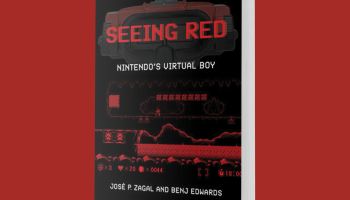
MIT Press‘s long-running Platform Studies series has used an academic lens to explore the technical aspects and cultural impact of a diverse array of video game consoles since it began in 2012. But after covering successful platforms such as the NES, the Super NES, the Wii, and the Atari 2600, the next book in the series will definitely surprise a few readers.
Jose Zagal and Benj Edwards have made the unconventional choice to focus on… wait for it… the Virtual Boy in Seeing Red: Nintendo’s Virtual Boy. More than just an infamous failure, the Virtual Boy offered a unique experience that still has people talking about it today:
With glowing red stereoscopic 3D graphics, the Virtual Boy cast a prophetic hue: Shortly after its release in 1995, Nintendo’s balance sheet for the product was “in the red” as well. Of all the innovative long shots the game industry has witnessed over the years, perhaps the most infamous and least understood was the Virtual Boy. Why the Virtual Boy failed, and where it succeeded, are questions that video game experts Jose Zagal and Benj Edwards explore in Seeing Red, but even more interesting to the authors is what the platform actually was: what it promised, how it worked, and where it fits into the story of gaming.
Nintendo released the Virtual Boy as a standalone table-top device in 1995—and quickly discontinued it after lackluster sales and a lukewarm critical reception. In Seeing Red, Zagal and Edwards examine the device’s technical capabilities, its games, and the cultural context in the US in the 1990s when Nintendo developed and released the unusual console. The Virtual Boy, in their account, built upon and extended an often-forgotten historical tradition of immersive layered dioramas going back 100 years that was largely unexplored in video games at the time. The authors also show how the platform’s library of games conveyed a distinct visual aesthetic style that has not been significantly explored since the Virtual Boy’s release, having been superseded by polygonal 3D graphics. The platform’s meaning, they contend, lies as much in its design and technical capabilities and affordances as it does in an audience’s perception of those capabilities.
Offering rare insight into how we think about video game platforms, Seeing Red illustrates where perception and context come, quite literally, into play.
Seeing Red: Nintendo’s Virtual Boy will be available in bookstores on May 14.

